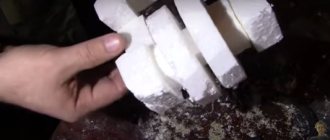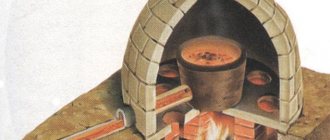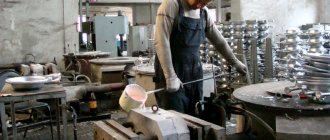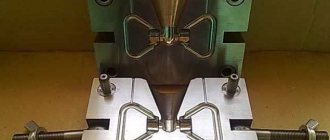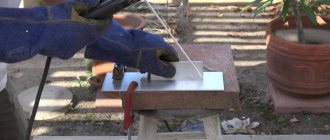Aluminum is a metal that is widely used in industry and everyday life.
It is used to produce not only aircraft and ship parts, but also dishes and other utensils. Therefore, there is often a need to independently manufacture aluminum parts that have failed.
The ability of aluminum to melt at relatively low temperatures makes it possible to produce cast products from it in artisanal conditions. In order to independently produce cast aluminum products, you need to know the behavior of this metal at high temperatures and its physical and chemical properties.
Characteristics of aluminum
The melting point of aluminum depends on the purity of the metal and is approximately 660 °C. Its boiling point is 2500 °C.
Aluminum is distinguished by its lightness and ductility, so it bends well and can be processed by stamping.
This metal is an excellent conductor of heat and actively enters into a chemical reaction at high temperatures with atmospheric oxygen, forming an oxide film on the surface. It protects aluminum from further oxidation, but when scrap melts, it significantly affects the composition of the alloy. During the metal smelting process, the structure of aluminum changes.
When it cools sharply, internal stresses and shrinkage of the resulting alloy may occur. This must be taken into account when working with aluminum at home.
Technologies for home aluminum casting and necessary equipment
The principle of casting aluminum at home should be based on the technology for its production in production, adjusted for conditions that can be used at home.
Aluminum products are produced by casting in several ways. In domestic conditions, the most common and convenient method is the technology of casting molten aluminum into specially made molds.
Therefore, to carry out the process, two things must be ensured:
- build a furnace for melting aluminum scrap;
- create the desired shape to produce a cast alloy or a separate part.
The casting process must include several stages:
- Preparation of aluminum scrap, including cleaning from dirt, impurities and various fillers, as well as grinding it to a small size.
- Carrying out the smelting process in the planned way. When the metal is completely melted, slag formations must be removed from its surface.
- Filling the prepared mold with liquid aluminum melt. After solidification, the ingot is freed from the molding mass.
Let's consider how to melt aluminum at home, what designs of furnaces for melting metal can be used, as well as options for making molds yourself.
Homemade furnaces and methods for melting aluminum
In order to melt aluminum, you need to heat it to a temperature close to 660 °C. It is impossible to reach such a temperature on an open flame of a fire. Therefore, a closed space is needed, which a homemade stove can provide. It can be heated by burning coal and wood or using natural gas.
You can also use an electric muffle furnace if you have one on the farm.
With a self-made stove, forced ventilation must be provided to maintain the combustion process.
1. The simplest version of a homemade fireplace can be made from old pots.
Its design is as follows:
- As a frame, use a steel container, for example, an old pan, on the side of which you need to make a hole to supply air through a connected metal pipe.
- Air can be forced through the hose using a vacuum cleaner.
- Coal is placed inside the device.
- Then the coal is set on fire and air is supplied to keep the fire from going out.
- A container for melting aluminum is first placed inside an improvised furnace structure and lined with coal on its sides. When it burns, uniform heat distribution is ensured.
- To prevent heat from being lost to the surrounding air, the top of the “pan” stove should be loosely covered with a lid, leaving a small gap for the smoke to escape.
An ideal design would be a firebox with an oval arch made from a masonry mixture used for heat-resistant bricks. You can use a flower pot of the desired size as a frame to create an oval vault.
After the mixture dries, a good firebox is obtained that can withstand several heats.
2. The second version of the furnace involves using the flame of a household gas burner to heat aluminum.
It can only be used for piece products made of aluminum weighing no more than 150 grams. An imitation oven is created by using two containers inserted into each other with a small gap. These can be ordinary cans from canned food.
Read also: DIY garage antenna
The outer jar should be larger. A hole with a diameter of about 4 cm is made in it to ensure the supply of flame to the inner can.
The flame jet should be directed towards the opening of the can. Only the inner container is heated directly, and the outer one serves as a shell that retains heat. The top of the structure must be covered with a simulated lid, leaving a gap for the removal of combustion products.
This design is disposable and can only be used for one melt, since the tin is thin and can quickly burn out.
Aluminum: characteristics
Before the discovery and implementation of an accessible method of industrial production, this metal was considered precious. At a certain historical stage, it was more expensive than gold. Its properties could be used in many industries. Aluminum is a lightweight and ductile material. It can be stamped, bends, and molds well into complex shapes, especially under pressure. Its melting point is 660 °C, which can be achieved without industrial equipment. This means that casting aluminum at home is quite possible.
Who will benefit from this? Aluminum is a proven material. It was used to make dishes and parts for the aviation and space industries. Castings with good thermal conductivity, corrosion resistance and acceptable strength are valued by tinkerers. The material is suitable for making souvenirs, decorative elements of utensils, for repairing or restoring parts and components in equipment.
How to cast an aluminum part
Metal characteristics
Aluminum is one of the cheapest, most common and accessible metals, which can be easily machined and cast. The main features of aluminum are high electrical and thermal conductivity, as well as increased corrosion resistance. The boiling point of this silvery-white metal is 2500 °C. Pure aluminum melts at a temperature of 660 °C, and technical aluminum - at 658 °C. Home heating devices are unlikely to be able to provide such a temperature, so it is better to use a crucible muffle furnace to cast an aluminum part.
Aluminum casting at home
The melting point can be reached without the use of industrial technologies in various ways. In the old days, blacksmiths forged steel and heated it with the energy of burning coal. This is the first option, but to implement it you will need a forced air furnace.
The second option is the use of natural or liquefied gas. The process can be organized in a homemade oven. There is another possibility if the melting volumes are insignificant. In this case, you can use a household gas stove.
Aluminum casting at home can also be organized if the household has an acetylene generator and a cutter. An option with an electric muffle furnace is also suitable. Such equipment can already be classified as industrial. But if you don’t want to make a stove, it’s quite possible to rent it and order the service of an operator.
Burnout casting: technology features
Manufacturing a part from aluminum using burn-out casting has its own characteristics, which will be discussed below. The work is performed in the following sequence:
- Foam plastic is used as a material for the model at home. Using cutting elements and glue, make a figure that resembles the required shape in outline.
- Prepare a container for making the model. You can use an old shoe box. Mix alabaster with water. Pour the mixture into the box. Place the foam model. Level it out. Give the material time to harden well. Due to the rapid hardening process of alabaster, perform the work at an accelerated pace.
- Remove the box. Heat the mold in the oven to dry the alabaster and remove any remaining moisture. Otherwise, all the water from the alabaster will enter the aluminum and turn into steam, which will lead to pores in the metal and aluminum splashing out of the mold during work.
- Melt the aluminum. Remove molten slag from the liquid surface. Pour the metal into the mold in place of the foam. Due to the high temperature, the latter will begin to burn out and aluminum will take its place.
- After the metal has cooled, break the mold and remove the resulting cast aluminum model. You can watch the process in more detail in the video.
Technological process
In principle, the situation of industrial casting should be modeled with a reservation for home conditions. In any case, it is necessary to prepare the raw materials. Aluminum scrap is cleaned of dirt, foreign impurities, and all kinds of fillers. Large parts are crushed to the desired size.
Aluminum casting technology consists of several stages. The prepared scrap is melted using the chosen method. When the fluid phase is reached, the slag is removed from the surface of the melt. In the final phase, the mold is filled with liquid metal. The disposable form breaks after cooling.
First you need to decide what is to be cast. Even if this is a trial attempt at melting, it makes sense to prepare at least some form. What if it is possible to reach the desired temperature? It is interesting to see the result of melting and evaluate the results: appearance, porosity, cleanliness. Any experience, even a bad one, will be beneficial.
Conditions and necessary equipment
When melting secondary raw materials, the coating burns, fumes are released, and there is smoke. Working in an enclosed space without an intensively functioning hood is problematic. The best option is open space.
Even in this case, an additional source of ventilation will be useful. Molding casting of aluminum into foam plastic is accompanied by intense release of combustion products. A fan with side ventilation of the work area will remove acrid smoke, which will ensure normal conditions for casting.
A well-equipped and well-organized workplace is also important. It is advisable to have sheet metal or another surface as a base on the table that is not susceptible to the high temperature of molten aluminum. The likelihood of splashes and spills of liquid mass is high. With this in mind, you should think about the need to carry out work in a residential environment.
Homemade smelting furnace
The easiest way is to take a few refractory bricks and build a fireplace out of them. It is convenient to do this in a suitable metal container (an old pan), which will be used as a frame. A hole is made on the side for connecting the air supply pipe. You can adapt a piece of metal pipe of suitable diameter. A vacuum cleaner hose, hair dryer or other air supply device is connected to it.
Charcoal (stone) charcoal is placed inside. The fire is lit and the air supply is turned on. The vessel where the aluminum will be melted is installed inside the furnace. It is also lined with coal on the sides. It is advisable to put a lid on the stove so that the heat does not go away in vain, but leave only a hole for the smoke to escape.
Ideally, the firebox is made solid with an oval arch. Special mixtures are used for laying heat-resistant bricks and lining furnaces. Such a structure can easily be built from an old bucket. The inner vault is formed using plastic flower pots of a suitable size. A metal mesh can be embedded inside the reinforcement mass. After the mixture hardens, you will get a high-quality furnace that can withstand more than one heat.
We will need:
- molding container;
- sand;
- Styrofoam;
- stove with burner;
- tool for processing foam and finished castings.
First of all, we start working with a template or drawing; I will tell you using the example of casting a souvenir. Prepare the template and cut it out. This is necessary in order to quickly transfer it to our foam. If you draw well, then you can draw the detail directly on the foam, it doesn’t matter. After which, we need to cut out our blank. This takes most of the time, since the work is painstaking, and the defect is practically impossible to fix (you can cut out the damaged part and glue a piece of new polystyrene foam with glue and try to cut it out again).
Next, I used a drill (engraver) and processed the edges more clearly, cut out holes and the product acquired a recognizable appearance. Here, by the way, I didn’t succeed the first time, since the cutter cuts the foam like a knife through butter and, due to torsion, is pulled further into the depths, so be careful and don’t overdo it. Otherwise you will have to start from the beginning, which is what I had to do!
Using a stove
Piece casting of aluminum can be organized without the manufacture of a special furnace. The required temperature is achieved using domestic gas. The smelting process itself takes about half an hour if the volume of aluminum does not exceed 100-150 grams.
A tin of condensed milk, for example, is used as a container. Cleaned and crushed aluminum scrap is poured into it. But you won’t be able to melt it by placing a tin can on the grate over the burner - there won’t be enough temperature. To reduce the loss of thermal energy, the inventors came up with a clever design.
A can of raw materials for smelting is placed inside another tin and placed on spacers so that there is a gap of 5-10 mm from the bottom to the bottom and from the sides to the walls. The second jar, accordingly, should be of a larger diameter. A hole (3-4 cm in diameter) is made in it from below to supply a jet of flame. The divider is removed from the gas stove burner.
The flame is ignited. The structure is installed strictly above its wick. The flame should go inside and heat only the tin with the crowbar. A larger diameter jar acts as a shell and retains heat inside. The opening is covered from above, leaving only a gap for the combustion products to escape. The combustion intensity is adjustable.
Crucible and auxiliary equipment
A tin can can withstand one heat. Its further use is possible, but with the risk of being burned through. In this case, molten aluminum runs the risk of getting inside the stove, which can not only lead to clogging of the burner nozzles.
To work in a furnace running on coal or liquefied gas, and indeed for reusable melts, it is advisable to make a special container - a crucible. It is made of steel. A piece of pipe with a welded bottom will do. A good option is made from a cut-off fire extinguisher or a small-sized oxygen cylinder with an oval arch. It is advisable to make a side gutter for easy pouring of a thin stream.
What additional equipment may be needed for aluminum casting? Reliable pliers or their version with clamp fixation will come in handy. Ideally, the crucible can be equipped according to the principle of industrial designs: with side grips of a removable suspension and a lower fixed stop for ease of turning it over. You need a spoon with a long handle to remove slag from the surface of the melt.
Simple forms
What are the methods for casting aluminum? The easiest way is to pour the molten metal into a metal mold: an old mug, a frying pan, a tin can. After cooling, the blank is removed. It’s easier to do this if you tap the mold while it’s not yet cooled down. If it had grooved sides or reverse corners, the frame will have to be cut. You can simply pour a slightly cooled drop of metal onto a prepared fireproof surface. Such methods are called open.
If there is a need to make a special casting, you first need to prepare a mold to fit it. In order for the metal to acquire clear outlines after cooling, closed molds are made from two or more component parts. One of them is the main one, and the other usually forms the arch or lateral surface. Holes are made in it. Often another part of the form is added above them - funnel-shaped flyers for convenience.
Complex products requiring skill and additional tools
If you have a welding machine, then you can make metal crafts of any complexity. Nothing will limit your imagination even if you purchase metal scissors. A small hammer and anvil make the process even more creative and varied. In this case, nothing limits either the skill of the craftsman or the flight of his imagination. Any idea can be realized, even using scrap metal.
Flat original designs
If you want to make a homemade product that will decorate your garden plot, the facade of a house or a fence, you can make a flat image of any animal, flower or other object.
In this case, you will need sharp cutting tools with which you can cut out the desired image. The main part of the work will be creating a suitable sketch.
After an object of suitable size has been created on paper or thick cardboard, you need to transfer it to metal.
Then use a cutting tool to cut out not only the outline. But, internal perforation is desirable. It is the internal holes in the flat sculpture that will help recreate the image in the most naturalistic way and give it some lightness.
Material
Aluminum casting molds, depending on the method, can be produced using different technologies. There are several simple options. For open pouring into a simple mold, sifted earth (silica) is often used. It is laid in layers and compacted. After removing the forming element, the earth holds its shape and withstands pouring. This material is simple and cheap to use.
There are craftsmen who pour aluminum into sand. When mixing, use liquid glass (silicate glue). There is information about the use of cement. The mixture is mixed, oddly enough, with brake fluid. Knead with your hands and rub through a sieve to avoid lumps. The consistency should be such that when clenched in a fist, a lump forms. When tamping, sand and cement are well held inside the flask and even repeat small details of the workpiece shape.
Materials for casting molds
With the open pouring method, the simplest material that is always at hand is often used, this is silica. First, the earth is laid with layer-by-layer compaction. A casting model is placed between the layers, which, after careful compaction, leaves an imprint in the silica. This mold is carefully removed and aluminum is poured in its place.
Some craftsmen use river sand with the addition of liquid glass when preparing the base of the mold. A mixture of cement and brake fluid is also sometimes used.
Plaster molds
When making a model of a complex shape, gypsum is often used, which can mainly be used for a one-time casting process. When casting aluminum into a plaster mold, paraffin or foam plastic is used as models.
The wax model of the product is filled with plaster and, after drying it at high temperature, it is melted and drained through a special hole.
If the model is made from foam plastic, it is filled with gypsum mixture and left in it until the mold completely hardens. Hot aluminum melt is poured directly onto the foam. Due to the high temperature of the metal, the foam melts and evaporates, and its place is taken by an aluminum melt, taking the shape specified by the foam.
When using polystyrene foam as a model, work must be carried out in an open space or the room must be well ventilated, since the combustion products of polystyrene foam are harmful to humans.
Typical mistakes and tips for proper casting
- When working with plaster, you should avoid common mistakes. Despite the fact that plaster molds are a convenient way to cast the desired configurations of parts, this material is very sensitive to moisture. During normal air drying, it remains part of the gypsum. This is detrimental to the quality of the aluminum casting, as it can cause the formation of small shells and bubbles. Therefore, plaster molds need to dry for several days.
- The metal must be hot enough before pouring to fill the entire mold before it begins to harden. Therefore, after reaching the melting temperature, taking into account the rapid cooling of aluminum, there is no need to delay pouring it into the mold.
- It is not recommended to immerse the resulting casting in cold water to speed up the hardening process. This can disrupt the internal structure of the metal and lead to cracks.
As an option, I can suggest making a mold for pouring from plaster or alabaster.
Provided that your part is not of complex shape and does not have intricate reliefs or internal cavities.
We prepare a container slightly larger in size than your part, you can use any ready-made cardboard box or make it yourself from any cardboard or corrugated cardboard, you can half a plastic bottle, dishes, the main thing is to then remove the resulting form for filling.
Coat the part with technical Vaseline or other thick lubricant.
We prepare two dowels for centering the shape of two halves, for example, saw off two 2 cm pieces from a pencil, coat them with Vaseline.
We choose alabaster to make the mold.
We dilute alabaster as follows: add the required amount of alabaster to a container with cold water, wait until the water is completely absorbed into the powder and then stir until a homogeneous consistency is obtained.
The solution should look like medium thick sour cream.
A viscous solution is obtained from the proportion of 1 part alabaster to 1 part water.
Dilute such an amount of solution to use it in one go, since the mixture will harden quite quickly and will need to be thrown away; there is no point in restoring it; the properties of alabaster are not restored.
Pour enough solution into the container so that your part is immersed halfway in it. This will be half of your shape.
It is important to position the part so that after the solution hardens, it can be removed from this half of the mold.
Along the diagonal of the mold, separately from the part, vertically immerse two dowels halfway.
When the solution hardens, we will try to carefully remove the part and return it to its place. Everything worked out, let's continue.
We make a gasket for the frozen mold from available materials: plastic film, tracing paper, thin paper, close only the mold, do not close the part. You can also lubricate it with Vaseline.
We make a cylinder with a funnel on the edge from plasticine at the distance from the part to the edge of the mold and place it in the mold, this will be the filling channel. Decide on the thickness yourself.
Read also: Setting up the carburetor of the Husqvarna 240 chainsaw
We dilute the required amount of solution and fill the part completely and wait for the second half of the mold to completely harden.
Then we remove the resulting form from the container, carefully separate it into two halves, take out the part and plasticine, and clean up the defects.
We connect the form, the funnel goes to the top, that’s it, you can pour aluminum.
After pouring and removing from the mold, it will be necessary to modify the poured part manually using sandpaper, needle files, a cutter, etc. to the size of the original.
For many, the term “foundry” is closely associated with back-breaking labor and specialized professional skills. In fact, casting a part from the required metal is possible for the most ordinary person without professional training at home. The process has its own subtleties, but it can be done at home with your own hands. Outwardly it resembles the production of lead weights for fishing. Features of the aluminum casting process are related to the technical characteristics of the material.
Manufacturing of complex shapes
Castings of complex configurations are made using a different technique. The most common material is gypsum (alabaster). Forms without reverse corners and undercuts can be collapsible and consist of two or more parts. They won't last long, but it's quite possible to get a few castings.
A complex knot or decorative three-dimensional model can be made once, but the mold will have to be broken. There are two methods at work. You can make a wax (paraffin) model and fill it with plaster. Later, during the intensive drying process, this material will melt and flow out through the flaps.
Casting aluminum into a plaster mold using foam plastic involves making a model of the future casting from this material. It is filled with the prepared mixture and cannot be removed. Molten aluminum is poured over the top. The temperature of the metal melts the foam, it evaporates in the process, and liquid aluminum fills the space vacated.
DIY aluminum products
This video is about how to cast a coral-like sculpture from aluminum cans. You can decorate your interior with such a product, for example, make lamps out of them yourself. You can use them as an original paperweight. This product is perfect as a gift for any occasion. The idea is not new, but has not yet become widespread. Therefore, if you give this souvenir, it will be a big pleasant surprise and you will definitely be the center of attention.
The author plans to accumulate 10 kilograms of aluminum and cast a meter-tall statue for his garden. In order for the sculpture to be visible from afar, he plans to make the relief structure larger.
Organization of the aluminum casting process
For casting, you can use any container, such as a bucket. But you can’t see aluminum flowing through a bucket and control how it spills. Therefore, in order for the process of storing liquid aluminum to be visible to the naked eye, a transparent aquarium is used in this video tutorial. The basis for it was a piece of plexiglass 2 millimeters thick, measuring 750 x 400 millimeters.
To create our product we need to melt aluminum. To do this, the author filled a crucible from a gas cylinder with soft aluminum cans. Then he lit a fire in the forge. This one is very economical, melts aluminum and brass, copper well, using regular firewood. The high temperature provides forced airflow through the grate due to the blowing of the vacuum cleaner. The temperature is such that, if not taken care of, it can melt iron. The master prefers a mobile forge to an earthen one, depending on how much more it meets the safety requirements. A mobile phone with molten metal inside can be dropped or overturned. For the same reason, a gas cylinder with two reliable grips is used as a crucible.
With such handles, the device will not tip over or turn over. When working with molten metal, safety comes first. Do not use tongs to hold, move or tip over a crucible containing molten metal. This is an unnecessary risk. Please note that the master does not separate the melt from the slag. The slag floats on the surface, protecting the aluminum from oxidation. The result is a fracture with a large percentage of useful metal. When casting from a crucible, aluminum is poured not over the edge, but through a hole, like from the spout of a kettle. This way, all the slag remains in the crucible, and the jet maintains a constant diameter.
Casting errors
Making molds from plaster is a convenient and inexpensive way. But there is moisture in the material. With natural drying it remains. When molten metal is poured, moisture begins to evaporate rapidly. Even intensive oven drying does not guarantee its complete absence. Depending on the amount of moisture remaining in the mold, the aluminum casting may have small pits or large frozen bubbles and craters.
If the metal was not heated up enough or it had time to cool before pouring, the aluminum does not pour out well and does not fill the volume of the mold. In fact, a drop is formed that does not have sufficient fluidity. The same thing can happen when using a small amount of metal in a cold form. Aluminum gives off heat quickly and does not have time to spread.
Experienced craftsmen do not recommend immersing the casting in water to speed up its cooling. In such a material, damage to the internal structure and the appearance of microcracks is possible. Such workpieces may not be suitable for subsequent turning.
Crafts that don't require special skills
Working with metal is difficult, but we have selected several options for products that can be completed with a minimum of effort. But imagination is still needed here.
Crafts made from thin sheet metal
If you purchase a thin sheet of metal, then work with sharp scissors. You don't need any additional equipment - you can make a figurine quite easily. We offer a product in the shape of an owl. To make it you will need to purchase:
- Sheet metal, narrow stripes.
- The backing is a wooden rectangular board no more than 0.5 cm thick.
- Nails fixing elements.
- Sharp scissors.
Sequence of work:
- It is necessary to draw a detailed sketch.
- Using a marker (preferably a permanent one), transfer the drawing from the sketch to a sheet of metal along the inside.
- Use sharp scissors to cut out the elements.
- Take a tool with which you can squeeze out bulges or draw grooves on the inside of the metal. A spoon with a rounded end handle will do.
- You can take additional elements, for example, buttons or plastic parts. They will serve as the eyes of a bird, or additional decorative elements decorating finished products.
- When the elements of the owl are cut out, you should begin to combine them into one finished product.
- Metal elements are fixed to the board using thin nails.
Crafts with your child
If there is a strip of thin metal, then working with it is quite simple. Therefore, it will be possible to involve the child in such manipulations.
It is very easy to make a snail from strip metal. To do this, you need to cut the required length of the tape. Then start wrapping it into a spiral.
The body is also made of sheet metal.
The main difficulty in this case will be in fixing the body and the spiral house. But here, too, ingenuity will come to the rescue. If it is not possible to fix it firmly, then you can use tape. This is especially true if the sheet of metal is quite thin and does not have significant weight.
You may wonder how aesthetically pleasing the shiny tape will look. Solving this problem is even easier - just take acrylic paints and paint the snail along with tape. It is the layer of polymer coating that will hide all the irregularities and additional materials used.
If it is impossible to work with tools, you should choose crafts that include finished metal products that should be combined with each other.
